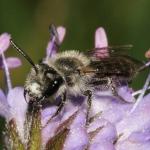Apis obscura LINNAEUS 1764; Nomada cingulata FABRICIUS 1775; Apis cetii SCHRANK 1781; Apis sphegoides PANZER 1798; Andrena suecica GMELIN 1790; Apis marginella GMELIN 1790; Melitta schrankella KIRBY 1802; Andrena frontalis SMITH 1849; Andrena fulva EVERSMANN 1852; Andrena hyalinella COSTA 1888; Andrena obsoluta Friese, 1914
In common with Andrena hattorfiana, the females of A. marginata occur in different colour forms. There are three such morphs in A. marginata: tergites mainly black or blackish-brown (resembling coloration of males); tergites 2-5 of gaster entirely (or almost entirely) pale orange (female of this form figured by Westrich (1989)); and an intermediate form in which the gastral tergites have orange and black bands. The very dark form is apparently dominant in south-west England and in Ireland (but apparently not in Scotland)
Local and uncommon though widely distributed in Britain and Ireland. In Britain it exhibits a disjunct distribution, occurring in many of the counties of southern England and south Wales, but being largely absent from the Midlands and northern England. However, it has been collected from several sites in central Scotland (though these are all old records). In Ireland it is known from Kerry, Carlow, Leix, Kildare, Wicklow, West Galway and Cavan. Widespread in Europe, ranging from southern Fennoscandia south to Spain, and east to Russia and Siberia.
A Notable A species (Falk 1991) (now known as Scarce (Na)).
Calcareous grasslands, heaths, moors, woodland and stabilised coastal dunes.
Univoltine; mid July to late September.
No information is available for the British Isles. In the former Czechoslovakia, the females are reported to nest solitarily in both loamy and sandy soils (Kocourek, 1966), though in Germany they nest both solitarily and in small aggregations (Westrich, 1989).
In addition to the species listed above, the bee visits knapweed (Centaurea sp.), nipplewort (Lapsana communis) and creeping thistle (Cirsium arvense). It is not known if these are pollen or nectar sources.
The rare Nomada argentata is a cleptoparasite of A. marginata (Perkins, 1919; Westrich, 1989). The conopid fly Physocephala rufipes has been seen apparently ovipositing on this Andrena in Norfolk (M Edwards, pers. comm.).
Profile written: 2001
Proofed: January 2012


